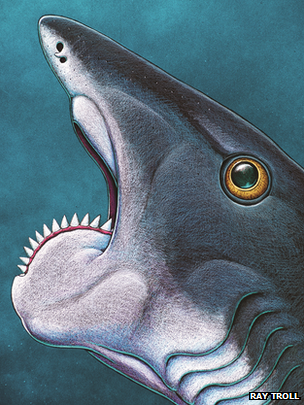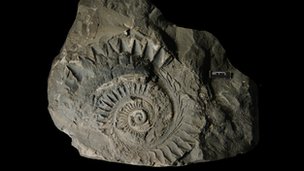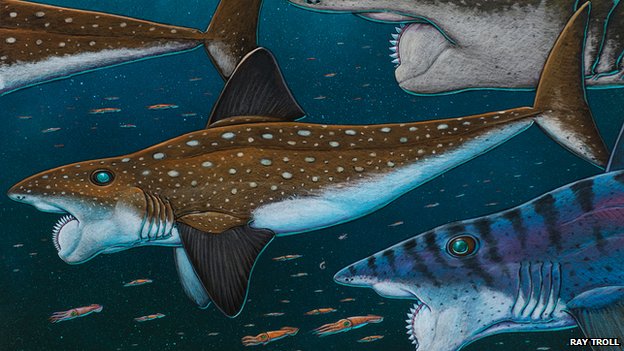It looks like you're using an Ad Blocker.
Please white-list or disable AboveTopSecret.com in your ad-blocking tool.
Thank you.
Some features of ATS will be disabled while you continue to use an ad-blocker.
5
share:

The fish lived 270 million years ago but because they were largely formed from cartilage, which does not preserve well, their fossil record comprises of unusual spiral structures.

Referred to as "whorls", these features have been compared to spiralling saw blades and have puzzled the scientific community for over a century. Early theories suggested that they were actually used for defence and were located on the fish's upper or lower jaws, or even the dorsal fin.

"As the mouth closes, the teeth spin backwards... so they slash through the meat that they are biting into," Dr Tapanila told BBC Nature. "The teeth themselves are very narrow: nice long, pointy, triangular teeth with serrations like a steak knife. "As the jaw is closing and the teeth are spinning past whatever it's eating, it's making a very nice clean cut." Of the 100 fossils of Helicoprion that have been discovered, very few show broken or worn teeth.
www.bbc.co.uk...
Astounded at how diverse nature is and was! I wonder if there were any skil-saw toothed land animals back then..
edit on 27-2-2013 by
canucks555 because: (no reason given)
reply to post by canucks555
I will say that it does make an interesting creature to look at, but apparently it didn't actually work out very well for them fundamentally.
I will say that it does make an interesting creature to look at, but apparently it didn't actually work out very well for them fundamentally.
reply to post by canucks555
I've seen pictures of these for a long time and for some reason I can't help but to think they have been misidentified somehow. I know they are 'extinct' as is most of the animals that have lived on this planet. Having said that I would like to add that you can see a lot of similar features of extinct animals on existing animals. Nowhere have I seen anything that looks like that other than a shell of some sort.
OR
Im a blithering idiot. (probably the right answer)
MOTF!
I've seen pictures of these for a long time and for some reason I can't help but to think they have been misidentified somehow. I know they are 'extinct' as is most of the animals that have lived on this planet. Having said that I would like to add that you can see a lot of similar features of extinct animals on existing animals. Nowhere have I seen anything that looks like that other than a shell of some sort.
OR
Im a blithering idiot. (probably the right answer)
MOTF!
Originally posted by MessOnTheFED!
reply to post by canucks555
I've seen pictures of these for a long time and for some reason I can't help but to think they have been misidentified somehow. I know they are 'extinct' as is most of the animals that have lived on this planet. Having said that I would like to add that you can see a lot of similar features of extinct animals on existing animals. Nowhere have I seen anything that looks like that other than a shell of some sort.
OR
Im a blithering idiot. (probably the right answer)
MOTF!
Well Blithering maybe, but not an idiot
hahah!
You have a great point. The only evidence they have is the fossilizes teeth imprints.
Because sharks have no skeleton, they assume that this thing is a shark. Same with Megaledon. (spll)
Maybe there were creatures that had cartilage skeletons, and looked nothing like a shark..
who's to say?
Isn't that fossil a nautilus shell? Seems to me like it is, because you can see the chambers they use for buoyancy control.
reply to post by MessOnTheFED!
[color=919191]There's a strong possibility of me having no idea what I'm talking about, but I think I might just go ahead and act as if I
do, anyways. The following is basically just me thinking out loud.
There are several different types of fossils. Some fossils consist of actual parts of the animal.(bones. teeth. etc..)
Another type is when the animal has actually dissolved in it's entirety, which means that the empty space was where the animal actually was, which left a sort of cast from around the outside of the animal. That's what the fossil in this OP, looks like to me.
I'm sure the people who dug it up know a little more about this than I do lol, but by just going off this 1 picture of the fossil, it seems to me that it is possible this was not a thin (blade-like) jaw, and was actually somewhat wide. If that was so, then it would slightly share one characteristic with sharks.
Sharks teeth move.(continuously, I think) Not fast, but constant. When/If they lose some, they've already got others right there waiting to compensate.
Maybe the 'Skill-saw Blade' was just an earlier version.

This↓ is kinda crazy. I never could have guessed anywhere near that many.
On the other hand, I agree with 'Iwontrun'. It sort of looks like a shell to me too.
Originally posted by canucks555
.....you can see a lot of similar features of extinct animals on existing animals. Nowhere have I seen anything that looks like that other than a shell of some sort.
There are several different types of fossils. Some fossils consist of actual parts of the animal.(bones. teeth. etc..)
Another type is when the animal has actually dissolved in it's entirety, which means that the empty space was where the animal actually was, which left a sort of cast from around the outside of the animal. That's what the fossil in this OP, looks like to me.
I'm sure the people who dug it up know a little more about this than I do lol, but by just going off this 1 picture of the fossil, it seems to me that it is possible this was not a thin (blade-like) jaw, and was actually somewhat wide. If that was so, then it would slightly share one characteristic with sharks.
Sharks teeth move.(continuously, I think) Not fast, but constant. When/If they lose some, they've already got others right there waiting to compensate.
Maybe the 'Skill-saw Blade' was just an earlier version.

This↓ is kinda crazy. I never could have guessed anywhere near that many.
A shark may grow and use over 20,000 teeth in its lifetime!
kidzone.ws...
edit on 2/27/13 by BrokenCircles because: (no reason given)
Could just be a simple case of misinterpretation but, on the other hand, teeth that are angled back combined with a very mobile lower jaw are quite
common in the reptile world. Particularly in pythons that have dislocatable jaws and angled teeth used to drag their large prey in whole.
new topics
-
University of Texas Instantly Shuts Down Anti Israel Protests
Education and Media: 1 hours ago -
Any one suspicious of fever promotions events, major investor Goldman Sachs card only.
The Gray Area: 3 hours ago -
God's Righteousness is Greater than Our Wrath
Religion, Faith, And Theology: 8 hours ago -
Electrical tricks for saving money
Education and Media: 11 hours ago
top topics
-
VP's Secret Service agent brawls with other agents at Andrews
Mainstream News: 12 hours ago, 10 flags -
Cats Used as Live Bait to Train Ferocious Pitbulls in Illegal NYC Dogfighting
Social Issues and Civil Unrest: 16 hours ago, 8 flags -
Nearly 70% Of Americans Want Talks To End War In Ukraine
Political Issues: 13 hours ago, 4 flags -
Sunak spinning the sickness figures
Other Current Events: 13 hours ago, 4 flags -
Electrical tricks for saving money
Education and Media: 11 hours ago, 4 flags -
Late Night with the Devil - a really good unusual modern horror film.
Movies: 15 hours ago, 2 flags -
Any one suspicious of fever promotions events, major investor Goldman Sachs card only.
The Gray Area: 3 hours ago, 2 flags -
University of Texas Instantly Shuts Down Anti Israel Protests
Education and Media: 1 hours ago, 1 flags -
God's Righteousness is Greater than Our Wrath
Religion, Faith, And Theology: 8 hours ago, 0 flags
active topics
-
Nearly 70% Of Americans Want Talks To End War In Ukraine
Political Issues • 36 • : Xtrozero -
University of Texas Instantly Shuts Down Anti Israel Protests
Education and Media • 3 • : CriticalStinker -
Sunak spinning the sickness figures
Other Current Events • 13 • : Xtrozero -
Any one suspicious of fever promotions events, major investor Goldman Sachs card only.
The Gray Area • 7 • : seekshelter -
Hate makes for strange bedfellows
US Political Madness • 42 • : network dude -
-@TH3WH17ERABB17- -Q- ---TIME TO SHOW THE WORLD--- -Part- --44--
Dissecting Disinformation • 663 • : MetalThunder -
Russia Ukraine Update Thread - part 3
World War Three • 5731 • : Freeborn -
President BIDEN Vows to Make Americans Pay More Federal Taxes in 2025 - Political Suicide.
2024 Elections • 137 • : CriticalStinker -
I think this life means something.
Philosophy and Metaphysics • 59 • : seekshelter -
Late Night with the Devil - a really good unusual modern horror film.
Movies • 5 • : chiefsmom
5
